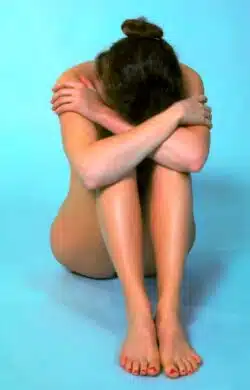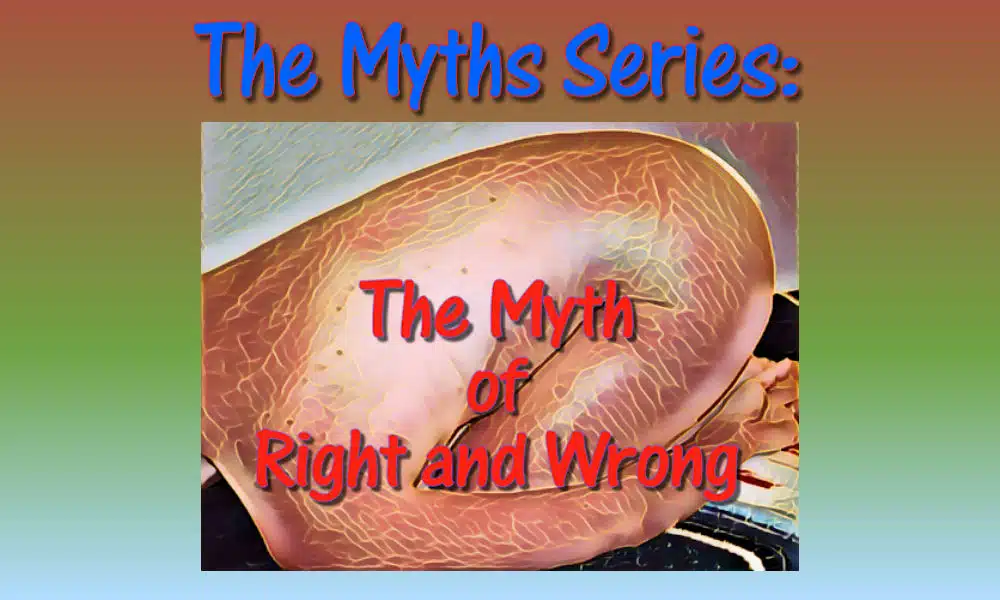- Life is not as it is. Life is as you are. The Myths Series
- The Myth of Absolute Truth — The Myths Series
- The Myth of Right and Wrong — The Myths Series
- The Myth of the Threat of Change — The Myths Series
- Unraveling the Myth of Shoulds — The Myths Series
- The Myth of Fairness — The Myths Series
- The Myth of No Consequences — The Myths Series
- The Myth of Easy — The Myths Series
- The Myth of Scarcity — The Myths Series
- The Myth of Limitations — The Myths Series
- The Myth of a Soul Mate — The Myths Series
- The Myth of Sex Equaling Intimacy — The Myths Series
- The Myth of a Self — The Myths Series
- 5 Ideas About Compassion
The Myth of Right and Wrong–there are always exceptions to each “rule,” and making a list isn’t particularly helpful
For more on this topic, check out:

My first and most popular book,
This Endless Moment.
Learn to live a full and satisfying life.
I suspect that, when most people say, “That’s wrong!” they mean “I wouldn’t do that!” — that they’d be scared to do…whatever.
The reason for this is how we learn “right” from “wrong.”
Being a child means having an almost instant feedback loop, otherwise known as parents.
- When we were kids, doing “wrong” got us punished, and doing “right” got us some form of reward.
- As adults, we still sorta expect this kind of feedback, even if we dread it. In fact, many people get married hoping to be parented, or to parent, their spouses.
And it’s quite funny how the focus of such folk is always external — on their partner — as opposed to self-reflective.
But back, briefly, to parenting.
The funny thing is, the vast majority of things declared by our parents and tribes to be “right” or “wrong” are simply their personal preferences.
For example, one woman I worked with decades ago grew up in a one-parent household. Her dad left when she was a kid. Her mom never got over his leaving her. On a regular basis, mom would say, “Men can’t be trusted. Every man will hurt and abandon you.”
Guess what my client believed? This mom-mantra became, for her, a “rule.” A “truth.” And indeed, every man she picked cheated on her, and then left her. She fervently believed that “this was the way it is,” and because of this, she created situations and circumstances that her men would do what she feared (expected.)
Thing is, there’s no “right” or “wrong” about it.
Additionally, there’s the whole issue (discussed at length in Ben Wong & Jock McKeen’s The NEW Manual for Life) of the repression of the authentic self that is a part of all human conditioning.
Babies come into the world as a bundle of potentiality. Each child is born with an authentic self — a unique set of ways of being and doing, and of all of that “stuff” will come under pressure.
This authentic self, this complete self, will be sliced and diced by what I call in my book This Endless Moment the T&C (our tribes and culture.) Parts of us (our skills, characteristics, and characters) will be approved of, and other parts will be rejected.
The parts that are rejected go background, and agitate and mess with us from what Jung called The Shadow.
An acquaintance of ours remembers having a deeply artistic bent when she was a kid. Her parents were in the sciences, and, using all kinds of manipulations, kept reinforcing the idea that “In our family, we don’t make art, we donate to the arts” and “Painting is not a career.”
When she was around the age 8 they took all of her art supplies away, and refused to buy her more. She stopped all forms of painting and art. They upped the ante and made art “wrong,” and had the power to enforce their belief.
Her artist finally went background.
Mom and dad continued to stress the sciences as the only “right” career. In her teens, she rebelled, but in a typically teen way. She didn’t go back and examine her parents’ assumptions — she had bought into their belief system, and declared, “I’m not an artist” and “Being an artist is bad.” What she did do was become sexually active at 14, and she dropped out of High School at 16, ending the whole “become a scientist” thing.
She became a secretary. She figured, “That’ll show them!”
Of course, she really only hurt herself, and totally missed what had been going on.

Ten years went by. During that time she painted three paintings. She hid them in the closet in her apartment. I saw one, one day — it was a depiction of three people in a very hot clinch. We started talking about art.
Over time, her story came out. With much effort, she let go of the art / science, “bad” / “good” nonsense, finished High School, and enrolled in a University Arts program.
But there’s more to the story.
T&C (often in the guise of parental lectures / diatribes) doesn’t stop pressuring for compliance when we become teens. All that changes is the “maturity” of the topics.
When my friend was a young teen, mom and dad started criticizing her appearance, clothes choices, and her developing body. When puberty hit, her mother continually stressed that sex was “bad,” — something to be put up with and gotten past.
Both messages “went in,” and changed her beliefs about herself:
- In my opinion she was quite attractive and well-proportioned. She needed to paint a self-portrait for Art Class, and I shot a portrait series for her. Lovely photos. Then I saw her sketches: she drew herself as old, ugly and fat. Because she had learned to believe that her that her body was “wrong.”
- Although sexually active since 14, she didn’t enjoy sex. She called it, “Going through the motions.” Just as mom taught her.
Each of her beliefs — her “good and bad list” — come from her formative years — and it is so for all of us.
As we get older, we do change some of the items on our “good” / “bad” list, but the hard part is when I suggest that people do away with lists entirely.
The problem with lists is that they let people off the hook. With a list,to default to, people no longer need to engage in moment-by-moment, issue by issue thinking.
And that’s too bad, because all people, given encouragement (notice that word en-courage-ment) have the ability to make ethical and behavioural choices situationally, and on the fly.
Since we met, Darbella and I have been experimenting with a radical idea. It’s simple. If something comes up and either of us want to attach a knee-jerk “right / wrong” label to it, we explore it.
If something scares us, we tend to do it. (see caveats, below.) And, if something interests us, we give it a shot.
This means that we are better able to spot any “right / wrong rules” we might have. We then examine the rule and see if it actually makes sense.
Besides, if we decide to do something despite our fear of it, will the sky fall in?
Better, we think, to actually find out through our own experience than to stop ourselves based upon someone else’s opinion.
Because in the main, the things we have the strongest reaction to tend to be the most embedded, and therefore taught to us by T&C. T&C had an agenda back then, and we forget that at our peril. They wanted to create clones that fit in.
Which is not to say, and here’s the caveat, that I’m going to try Russian roulette. I also have opted out of bungee jumping. Not because someone else told me to, but because my fear-level is sufficient to not need to test these things.
On the other hand, discovering and exploring the pieces of my authentic self — the parts of me that my parents taught me to put away, actually liking and using and training my body — well, that’s a different story.
Take a look at the things about yourself that you declare to be “bad.” Are they really “bad,” or did they just fly in the face of what your tribe wanted of you? Explore what you judge to be “wrong” about others. Same criteria. Is it “wrong,” or just different? (This is especially true of cultural judgements, aka racism. Almost all of it is “just different.”)
And lastly, look at those actions and acts you think might be fun — but you just know are “wrong!!!!” Why? What would it be like, with a clear heart and total honesty, to give one or two a chance? Then decide if you want to repeat the experience.
Because, speaking for me, I don’t want to be lying on my death-bed with a ton of regrets.
If it’s scary, chargy, or new, just do it.

